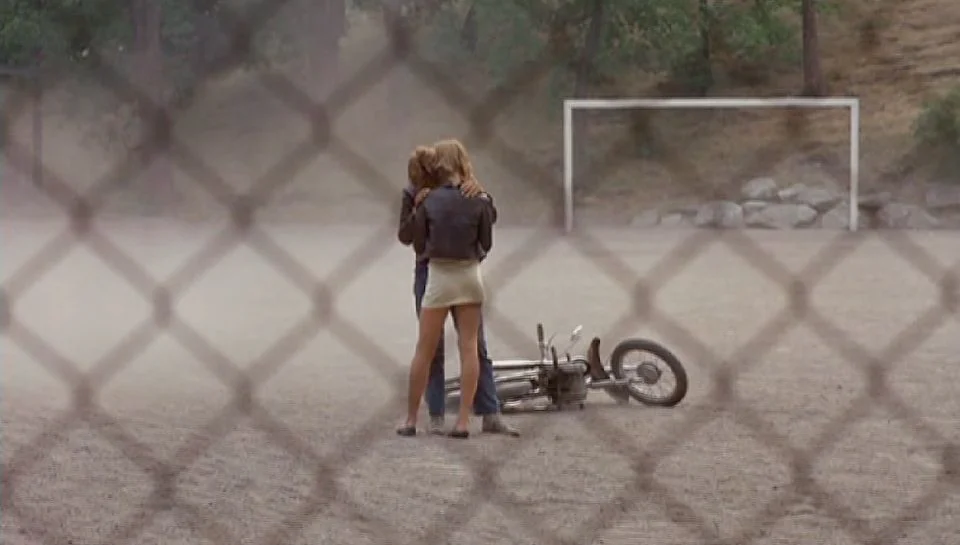Jonathan (Hans W. Geissendörfer, 1970)
May
26
World Dracula Day

Siring the mortals. DP: Robby Müller.
A vampire for World Dracula Day
This deeply political, unpleasant interpretation of Stoker's Dracula can not not be seen against the backdrop of political movements like the #RAF and West-Germany's youth revolting against the failed #Denazification that the country underwent under supervision of the Allied occupying forces.
Note the usage of colour and grouping of people; Klaus Mann's Mephisto (1981) borrowed quite a few visuals from Jonathan.
1970s
“Rule Britannia, Britannia, Britannia…”Jubilee (Derek Jarman, 1978)
May
24
Tiara Day

Bod (Jenny Runacre), wears a Crown Jewel-ish affair. Amyl Nitrate (Jordan) clutches her pearls. DP: Peter Middleton.
A “member of a monarchy” for Tiara Day
– Amyl Nitrite
Queen Elizabeth I (Jenny Runacre) requests Her court occultist John Dee (Richard O'Brien) to show Her Majesty the future of Her kingdom, baroness Thatcher's rotten England, ruled over by a gang of nihilist women.
“Soyez réalistes, demandez l'impossible”Grands soirs & petits matins [May Days] (William Klein, 1978)
May
24
1968

Sorbonne students discussing the political situation with an elderly Parisian man. DPs: William Klein & Bernard Lutic.
– May 68 slogan
“Ja sam vaša budućnost”Mlad i zdrav kao ruža [Young and Healthy As a Rose] (Jovan Jovanović, 1971)
May
21
Employee Health and Fitness Day

Stiv (Dragoslav 'Dragan' Nikolić) working out. DPs: Petar Lalović & Petar Dositej Aranđelović.
A character who works out on Employee Health and Fitness Day (USA)
– Stiv
Touha zvaná Anada [Desire Called Anad / Adrift] (Elmar Klos + Ján Kadár, 1968/1971)
May
20

Zuzka (Milena Dravić) holds a mirror to Anada's (Paula Pritchett) face. Zuzka's husband Jánoš (Rade Marković) looks on. DP: Vladimír Novotný.
“For a handful of coins!”L'uomo più velenoso del cobra [The Man More Venomous Than the Cobra / Human Cobras] (Bitto Albertini, 1971)
May
19

Leslie (Erika Blanc) and Tony Garden (George Ardisson). DP: Emilio Foriscot.
Den vita väggen [The White Wall] (Stig Björkman, 1975)
May
17
från Sverige

Monika (Harriet Andersson) (via). DP: Petter Davidson.
An actor, director, or character from Sweden for OP Bramble Jim's Swedish grandma's birthday (happy birthday, Grandma!).
Monika – in spirit the Monika from Bergman's Sommaren med Monika (1953) – is middle-aged, unemployed, and in limbo. We follow her life for a single day.
The Trial of the Catonsville Nine (Gordon Davidson, 1972)
May
17
1968
.jpg)
Director Gordon Davidson and the defense attorney (David Spielberg) on set. DP: Haskell Wexler.
En kärlekshistoria [A Swedish Love Story] (Roy Andersson, 1970)
May
7
National Hug Holiday Week

Pär (Rolf Sohlman) and Annika (Ann-Sofie Kylin) hug on a deserted barren soccer pitch. DP: Jörgen Persson.
A hug, romantic or platonic, on the first day of National Hug Holiday Week (USA)
Two teenagers in love become increasingly oblivious of the grey world around them.
